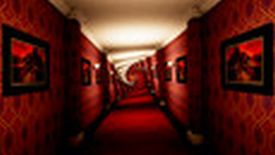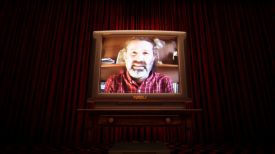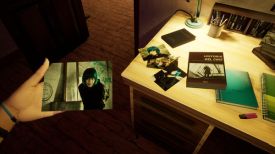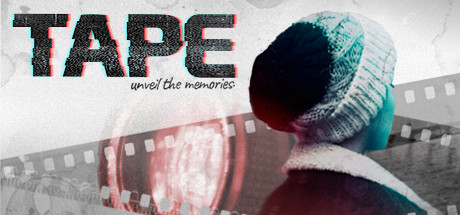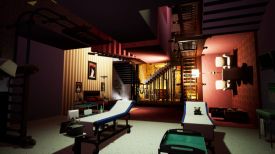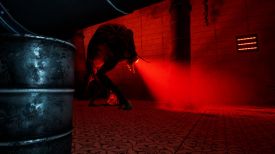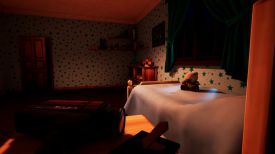|
By flotsam
TAPE: Unveil The Memories
BlackChiliGoat Studio
Before we begin, I need to
mention one thing. Which is that just after I finished playing the game,
the ‘goats’ released an update that created a ‘narrative’ version, which
in essence removed a big bad beasty from the game, enabling ‘the player’
to focus on the story and the puzzles.
It isn’t, as they said, the
experience they designed, but there it is. Kudos to them for making it
so.
Having now played the narrative
version, I will tell you about both.
Hailing from a Spanish indie
studio, TAPE describes itself as a puzzle
thriller about Iria, a girl with a special camera capable of affecting
time, who needs to explore her past to reveal what happened to her lost
father.
The camera is special indeed,
enabling Iria/you to rewind, fast-forward or pause objects in time. An
old Super8 sort of thing, it's essential in moving through the game.
While it felt a bit gimmicky at first, and had
its frustrating moments, I grew to rather enjoy it.
The game plays in the first
person and is in Spanish with English subtitles. It takes place indoors,
(exactly where you can find out for yourself), and you spend most of the
game exploring the environment and finding things that will let you into
other rooms and corridors. You will pick up many more things than you
take with you – pictures, drawings, letters and other documents - which
tend to fill in the story and some of the broader background, although
some provide clues to the puzzling.
Given the role of the camera, it
should come as no surprise that films feature throughout. The
paraphernalia of the industry is everywhere. Spot the homage became a
bit of a thing.
An aspect that might deter some
adventure game players is the large robot-like being that is present
throughout the game. You need to avoid it; if it catches you, it isn’t
game over but you will find yourself coming to somewhere on the floor
nearby and needing to try again. You can outrun it, hide from it
(something I did a lot of), manipulate it (sometimes) with light, even
pause it briefly using your camera, but evade it you must.
Some of the time the challenge
involved is not much more than nuisance value, but it can be rather
tricky. It ramps up as you move through the game, and there will be
times when you will have to hide and move multiple times, all while in
the middle of manipulating things that need to be manipulated. Not to
mention having to charge the camera somewhere in there too. There were
also occasions when I was heading confidently for an exit only to
suddenly have the robot entity spawn into being through a portal right
in front of me, which sent me madly running elsewhere.
It can be frustrating, sometimes
fiddly, but the beast isn’t terribly smart or fast (both of which help)
and aspects of the puzzle design can also assist. First among those is
that things you move through time follow their own path, which means
pointing the camera at them will (eventually) get them to where they
need to be. You might have to move things out of their way, or do some
things before others, but you don’t have to eg., click and drag or in
some other way work out where the particular object has to be. Which
makes some sort of sense; you are forwarding or rewinding time, so
things you can manipulate will necessarily move along their time
continuum.
As well, things might be where
you left them. Not everything, but some puzzles will leave the object
wherever it was when you had to break off and hide, or move to a
different location to avoid an object blocking your view. Near as I can
recall this was the construction whenever the beast was about. Puzzles
in which eg., the object moved itself back towards where it came from,
or which required a sense of timing to complete, happened in the peace
and quiet of no beast.
In the narrative version you
might hear and see the beast, but apart from one short, straightforward
running away requirement, it either won’t bother you or more usually
simply isn’t there. In its absence, a number of puzzles don’t exist, and
some rooms become nothing more than simply find the door to exit. But
you are left alone to explore, to find the things you need, to eke out
the story and most importantly to work out the camera manipulations. I
confess I rather enjoyed it, even playing it so soon after that I knew
how to solve most of the puzzles. It did though lack a little something.
I usually play games on ‘normal’
when that option is presented to me, so would probably have played the
non-narrative one first even if both had been available. But, and while
I acknowledge the views of the makers, in retrospect I would have
preferred to have done it the other way round; instead of the narrative
version lacking something, the beast version would have added something.
What you can’t do is have both
versions on the go at once. Starting one version erases the other, no
doubt a product of the save system. The game exclusively autosaves, and
all you can do is play from the last checkpoint you reached. You can’t
load earlier save points.
Which is a bit of a shame, but
who knows, maybe that update will come next!
I mentioned charging the camera,
which isn’t really how the game would describe it, and it is also a
little more complex than just being full or along the way to being
empty. I will try and (briefly) explain.
The camera has 15 ‘minutes’ of
stored time, which can be used to rewind or fast forward things. But
like time itself, it’s a relative concept. So you might send something
10 minutes into the past, bringing the charge to nearly zero in that
direction, but you can then send something else 10 minutes into the
future, which results in the time charge being back where you started.
You might bounce around between moving things forwards and backwards and
never exhaust the camera, and a sliding ‘scale’ will tell you exactly
where you are. However if everything in the puzzle has to move
backwards, eventually you will need to charge the camera for that to be
able to happen.
Which you do by taking time from
other objects, achieved by simply pointing and shooting the camera at
them. So long as they are the right sort of object, which you will
quickly learn to recognise. In that regard, early on the game provides
little ‘tutorial’ clues to help you settle in.
You need to be looking through
the camera to ‘see’ the things that can be moved, as well as in which
‘timely’ direction/s that can occur. Its another part of the puzzling.
While they don’t always make
conceptual sense, and some were a touch cantankerous, I liked the camera
conundrums. Need to keep a door open? Point your camera and pause it
from closing. Need to rebuild a broken staircase? Find the pieces and
reassemble them. Was that bricked up space once a door? Locate the parts
and ‘rewind’ until the door is again a door. The fact that you can eg.,
find yourself walking on the ceiling, or dropping through a door in the
floor or even needing to rotate whole parts of a room added to the mix.
Having said that, I would
probably have left out the latter part of the final stairway puzzle, and
perhaps there is one too many ‘stepping stone’ puzzles.
You will need to find a
relatively small number of items, and having them will cause them to be
used when needed, so there is no inventory management. Active items will
highlight as You will also pick up and examine numerous items – photos,
notes, newspapers, drawings as well as the movie bits and pieces – some
of which might provide a clue to a puzzle, more of which will help
reveal the story. Which is not a bad one.
Two choices towards the end of
the game will determine how the story plays out, and will unlock what is
called a Directors Cut. In essence it’s the final chapter, enabling you
to make different choices to see how the end might change. It's another
nice touch, one that is necessary given the save system.
It sounds good (save for one
dodgy bit of voice acting), especially musically, almost every piece
(and there are lots of them) being original. Not everything is
underpinned by a score, which I always like. It isn’t as highly polished
visually as some games, but it suits the somewhat surreal vibe.
The game plays in the first
person and utilises the keyboard and mouse. Use the mouse to operate the
camera and to ‘look’ about, and the keyboard for everything else. WASD
walks you around, and you have complete freedom of movement and vision.
A small round ‘curser’ fixed in the centre of the screen is your means
to access the world; items you can interact with will light up when you
are close enough and the curser is placed on them, and the curser will
also slightly enlarge. It works well.
Two grumblements were that the
key mapping wasn’t particularly to my liking (there is no menu to change
them to suit) and there were times when I wished the camera would deploy
more quickly. They were minor things.
TAPE took me about 7 hours the
first time through (what with all the running away) and I ended up
liking it a lot more than I thought I might.
I played on:
OS: Windows 10, 64 Bit
Processor: Intel i7-9700K 3.7GHz
RAM: Corsair Dominator Platinum RGB DDR4 32GB
Video card: AMD Radeon RX 580 8192MB
GameBoomers Review Guidelines
May 2022
design copyright© 2022
GameBoomers
Group
 GB
Reviews Index GB
Reviews Index |
